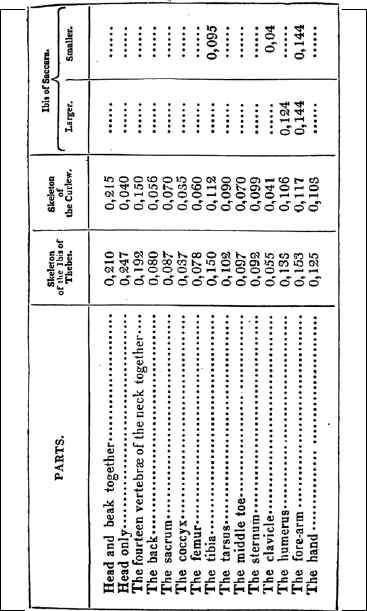 |
smaller than those of the tantalus ibis of naturalists;
that they were but very little larger than those of the
curlew; that the beak resembled that of the latter, only
being somewhat shorter in proportion to its thickness,
and not at all similar to that of the tantalus; in fact,
that its plumage was white, with the plumes of the
wing marked with black, as stated by the ancients.
 We were then convinced that the bird embalmed by We were then convinced that the bird embalmed by
the ancient Egyptians was certainly not the tantalus
ibis of naturalists; that it was smaller, and that it must
be of the curlew genus.
 We learnt, after some research, that the ibis We learnt, after some research, that the ibis
mummies opened before by other naturalists were
similar to our own. Buffon expressly says, that he had
examined many; that the birds they contained had the
beak and size of curlews, and yet he blindly follows
Perrault, in taking the tantalus of Africa for the ibis.
 One of these mummies opened by Buffon is still in One of these mummies opened by Buffon is still in
the Musuem, and is similar to those which we have
opened.
 Dr. Shaw in the supplement to his travels (fol. edit. Dr. Shaw in the supplement to his travels (fol. edit.
Oxford, 1746, plate 5, pp. 64 to 66,) describes and
depicts with care the bones of a similar mummy, the
beak, he says, was six English inches in length, like
that of the curlew, &c. In a word, his account exactly
tallies with our own examination.
 Caylus (Recueil d'antiquitiés Caylus (Recueil d'antiquitiés ,vol. vi. pl. 11, fig. 1,) ,vol. vi. pl. 11, fig. 1,)
represents the mummy ibis, as only one foot seven
inches high, including its bandages, al though he
expressly says, that the bird was then placed on its
feet, with the head erect, and that no part of it had
been bent in the embalming.
 Hasselquist, who took a small black and white Hasselquist, who took a small black and white
|


 1-10
11-20
21-30
31-40
41-50
51-60
61-70
71-80
81-90
91-100
101-110
111-120
121-130
131-140
141-150
151-160
161-170
171-180
181-190
191-200
201-210
211-220
221-230
231-240
241-250
251-260
1-10
11-20
21-30
31-40
41-50
51-60
61-70
71-80
81-90
91-100
101-110
111-120
121-130
131-140
141-150
151-160
161-170
171-180
181-190
191-200
201-210
211-220
221-230
231-240
241-250
251-260


![[made with GoClick]](imgs/goclick.gif)